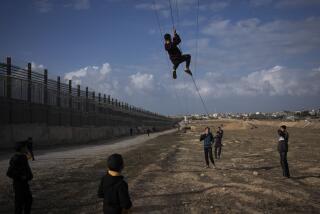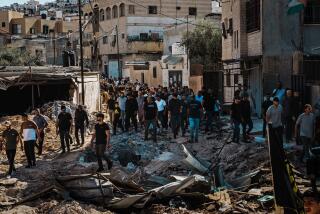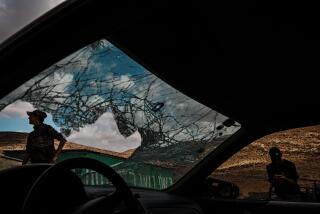U.S. military hits a wall in Iraqi militia stronghold
BAGHDAD — In the glow of a full moon, a U.S. military convoy inched toward a strategic road in Sadr City. The goal: to add to a wall being built to carve out a haven in the Shiite Muslim militia stronghold.
But the mission ended before it began. Machine gun fire blasted out from the third floor of a building along the route. A Bradley fighting vehicle fired back, sending a thunderous roar through the neighborhood of middle-class homes and businesses. Then, the lead tank hit a roadside bomb.
As gunshots and grenade blasts raged in the night, the two Iraqi construction workers accompanying the troops quit.
Army Capt. Alan Boyes wasn’t worried. None of his men were injured, and at $500 a day, he knew that the contractors hired to operate a crane to install 6,000-pound slabs of the wall would be back or that others could be found to replace them. But the violence that night and several attacks since highlight the hurdles American troops face as they try to take on fighters loyal to Shiite cleric Muqtada Sadr without plunging into the heart of his stronghold and sparking an all-out uprising of his heavily armed followers.
“Everyone knows we won’t go past Route Gold,” Boyes said, referring to the street along which the wall is being built, separating more than two-thirds of Sadr City from a rectangle where U.S. forces occupy a smattering of small bases. “It’s a political thing.”
It is also the same position the U.S. faced 15 months ago, when the first of 28,500 additional American troops arrived in Baghdad to help quell violence. At the time, commanders opted to not pour troops into Sadr City as they had done in other trouble spots, fearful that it would spark a bloody backlash from Sadr’s Mahdi Army militia.
Little has changed in the 11-square-mile corner of northeast Baghdad, but the stakes are higher now. An Iraqi military offensive launched against Shiite militias in late March has drawn in U.S. troops and has led to near-constant fighting in Sadr City. Sadr has threatened “open war” if the offensive does not end. U.S. troop deaths have climbed to their highest level in seven months, mainly because of the clashes in and around Sadr City, and the additional American troops will be gone by July. On Saturday, the Iraqi government said it had struck a deal with Sadr’s aides to halt the fighting, but the two sides disagreed on its terms and it was unclear what it would yield.
For Boyes’ team, each attempt to add to the wall, which is designed to run the 3-mile length of Route Gold, is a combat mission. But the military has made it clear it won’t cross the road, whose formal name is Al Quds Street, even as the Pentagon stepped up accusations that Iranian-backed fighters were using the area beyond as a base to launch attacks that have killed scores of U.S. and Iraqi forces and civilians in the last month. U.S. and Iraqi officials say they have uncovered evidence of Iranian involvement in training and supplying fighters in Shiite militia strongholds.
“There’s always a danger in giving an insurgent force a safe haven, but you always have to look at the strategic consequences,” Army Lt. Col. Mike Pappal said.
By building the wall, which will be about 12 feet high, Pappal said, the military will protect people on its side of Route Gold and limit escape routes for insurgents. It also will push back the Shiite fighters who launch mortar rounds and rockets at the Green Zone, which includes the U.S. Embassy and most Iraqi government offices. From the far side of Route Gold, it will be much more difficult for them to hit their targets.
Once the wall is completed, the military says, it plans to lavish streetlights on the neighborhoods it occupies and install other improvements in hopes of encouraging residents to reject extremism. Construction began April 15, but it will not be completed for several more weeks in part because of the delays caused by combat.
The United States’ predicament is a sign of Sadr’s status as a political power broker. He controls 30 seats in parliament, and his weekly messages read out in mosques across Iraq have a huge effect on violence in Sadr City and other Shiite neighborhoods of Baghdad.
“When he says stop shooting, they do as he says,” Boyes said, citing Sadr’s March 30 call to halt violence. It brought an immediate end to the shower of rockets and mortar shells that had been pummeling the Green Zone. Rocket fire resumed two weeks later and has remained relatively consistent since Sadr rejected Prime Minister Nouri Maliki’s demands that he disarm the Mahdi Army militia.
The streets surrounding Boyes’ base, a former butcher shop, were prime rocket-launching terrain before the troops moved in. Sandbags and concrete walls surround the structure. Cots cover virtually every inch of the floor inside except for makeshift footpaths. More cots are outside beneath the trees. Day and night, most are occupied by troops sleeping, reading or watching movies on their laptops.
There is no running water, and the troops use outhouses.
But it’s luxurious compared with Patrol Base Texas, a four-story structure overlooking a field in the Jamila neighborhood that militiamen once used for mortar and rocket attacks. Here, troops sleep sprawled on marble floors or, to escape the stifling heat, on the concrete rooftop beneath camouflage netting. Occasionally, sniper bullets zing past.
These bases did not exist until the third week in March, when the military decided it needed a foothold here. Most offer high floors for long-range viewing to help keep potential attackers at bay.
There is a limit to what soldiers can do without crossing Route Gold, but they say to be more aggressive would risk bloodshed worse than that during Mahdi Army uprisings in 2004.
Now, the main roads of Sadr City are peppered with roadside bombs that can pierce armored vehicles. The military says militiamen are positioned in residential areas, increasing the risk of civilian bloodshed if U.S. forces fire at them. Sadr officials say U.S. helicopters already have killed scores of civilians in errant assaults.
“There are days when you wish there were no restrictions. Then you have more clearheaded moments when maybe you say this is for the better,” said Army 1st Lt. Matt Vigeant, who acknowledged the frustrations of not being able to go after high-level militiamen suspected of hiding in Sadr City.
Sadr insists that his cease-fire remains intact, and has urged his followers not to attack Iraqi troops, but he says they have the right to defend themselves against U.S. forces. In a statement April 25, Sadr emphasized that his warning of “open war” applied only to American forces.
To the U.S. military, the truce is as good as dead. “The reality is, all bets are off,” said a military official, who spoke on condition of anonymity because of the political nature of his comments.
During a visit to Baghdad on April 20, Secretary of State Condoleezza Rice blamed the Mahdi Army for fighting in Sadr City and the southern city of Basra and ridiculed Sadr as a man who remains safe in Iran while his followers fight his war.
But still, American forces on the ground have to tread lightly, leaving them to erect their wall chunk by chunk while trying to win over people in the small area in which they operate.
Most say whatever support Sadr has is coerced, either through fear or economic pressure, and this makes their job difficult.
“This is really like an episode of ‘The Sopranos,’ ” said Sgt. Erik Olson, who spends much of his time visiting Jamila residents. “Every business out there is having to pay a percentage” to the Mahdi Army.
“They get a piece of everything,” he said.
As the fighting drags on and as the wall goes up, the Americans are banking on residents here doing as Sunni Muslims did in western Anbar province: rejecting insurgents and allying themselves alongside U.S. and Iraqi forces. But they acknowledge that this will be more difficult in Sadr City, given Muqtada Sadr’s control over much of the populace, his political clout and a family name that automatically earns him devotion from many. Sadr’s father was a revered grand ayatollah slain on orders of Saddam Hussein along with two of Sadr’s brothers.
Olson said that establishing a Sons of Iraq group, security volunteers who receive $10 a day from the U.S. military and who are credited with decreasing violence in cities and villages outside Baghdad, had been discussed in Jamila. The military even gave neighborhood leaders money to go hire some.
“But they came back,” Olson said. “They didn’t think Sadr City was ready for it yet.”
--
More to Read
Sign up for Essential California
The most important California stories and recommendations in your inbox every morning.
You may occasionally receive promotional content from the Los Angeles Times.











